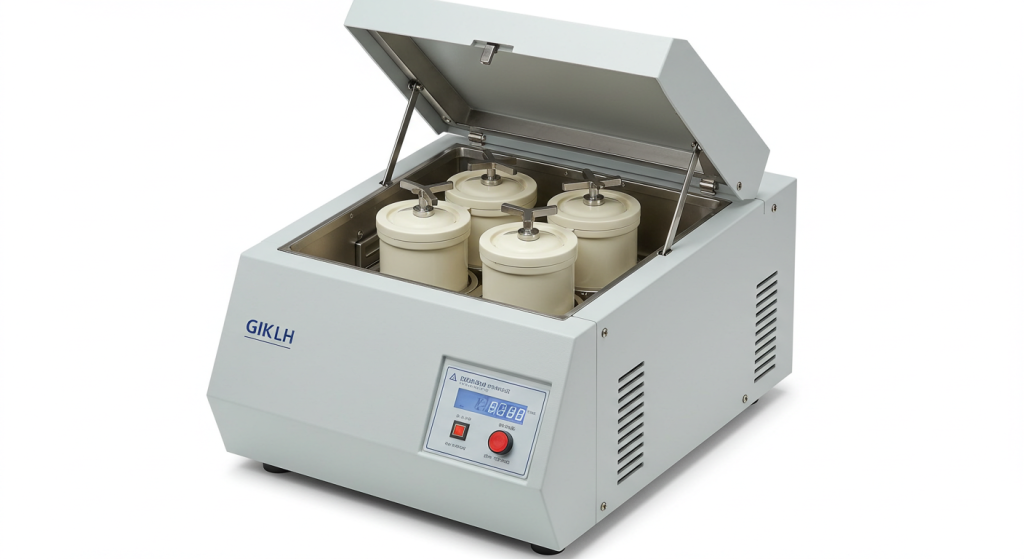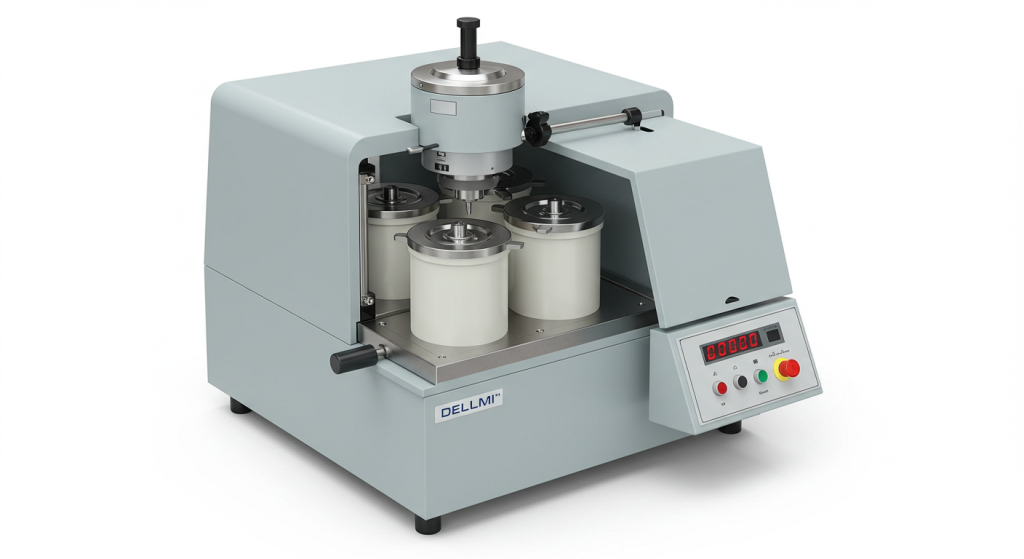In the diverse landscape of materials processing, the ability to refine and manipulate materials at a micro and nanoscale is essential for various applications. Among the methods used for size reduction and material mixing, the roller ball mill stands out as a versatile and reliable tool. This article will explore the intricacies of roller ball mills, examining their working mechanisms, advantages, and the critical factors that influence their application. We aim to provide a thorough understanding of how these mills contribute to both laboratory research and industrial processes.

Understanding the Basics of Roller Ball Mills
A roller ball mill, also referred to as a jar rolling mill, is a type of milling equipment used to grind, mix, and blend materials. It operates by placing the material to be milled and grinding media (typically spherical balls) into a cylindrical jar, which is then placed on a set of rotating rollers. As the rollers rotate, the jar turns, causing the grinding media to tumble and impact the material, reducing it into finer particles.
The effectiveness of a roller ball mill depends on several key parameters, including the speed of rotation, the size and type of grinding media, and the duration of the milling process. The gentler nature of this type of mill makes it ideal for certain materials where high impact grinding is not required.

Key Components of a Roller Ball Mill
Understanding the components of a roller ball mill is vital for effective operation and maintenance. These parts are all critical for the proper function of the system:
Essential Components of a Roller Ball Mill:
- Rotating Rollers: The cylindrical rollers that provide the driving force to rotate the milling jar.
- Milling Jars: The containers where the material and grinding media are placed.
- Grinding Media: Spherical balls that are placed inside the jars to grind the material.
- Drive Mechanism: The motor and associated components that power the rotating rollers.
- Support Frame: Provides stability and support for all the parts of the system.
How Roller Ball Mills Function
The operation of a roller ball mill is relatively straightforward. The milling jar, containing the material to be ground and the grinding media, is placed on the rotating rollers. As the rollers turn, they cause the jar to rotate. This rotation results in the grinding media tumbling and impacting the material inside the jar.
This tumbling and impacting action effectively reduces the particle size of the material over time. The milling time required depends on the properties of the material and the desired level of fineness. This gentle tumbling action is ideal for applications that require less intense grinding action.

Applications of Roller Ball Mills
Roller ball mills are used across various scientific and industrial fields for a wide range of milling applications. These applications include:
Common Applications of Roller Ball Mills:
- Sample Preparation: Grinding and mixing of samples for laboratory analysis.
- Mixing and Blending: Creating homogenous mixtures of powders, liquids, and pastes.
- Gentle Milling: Reducing particle size of sensitive materials that can degrade when high impacts occur.
- Grinding of Minerals: Size reduction of various minerals for processing.
- Ceramic Processing: Grinding and mixing ceramic powders for further processing.
- Paint and Pigment Production: Creating fine pigment suspensions.
The Versatility of Roller Ball Mills
Roller ball mills are valued for their versatility in handling a variety of materials. Their adaptability to different materials and applications makes them an important tool for both research and production. The versatility of these systems stems from their design and functionality.
Advantages of Roller Ball Mills:
- Gentle Milling: Suitable for heat-sensitive or fragile materials.
- Wide Material Compatibility: Can process a variety of solids, pastes and liquid mixtures.
- Ease of Use: Relatively simple to operate and maintain.
- Scalability: Available in various sizes for small laboratory batches to larger production runs.
- Mixing and Blending: Capable of producing homogenous mixtures.
- Low Cost: Generally more affordable than high-energy mills such as planetary ball mills.
Key Factors Influencing Roller Ball Mill Performance
The performance of a roller ball mill is influenced by several key parameters, and the optimal setup will depend on the material being milled and the results desired:
Factors Affecting Roller Ball Mill Performance:
- Rotation Speed: Adjusting the speed of the rollers impacts the rate of grinding.
- Grinding Media Size: Different sizes of grinding media will result in varying levels of grinding.
- Grinding Media Material: The material used for the media will have an impact on grinding efficiency and contamination.
- Milling Jar Material: The material of the jars should be chosen to be compatible with the material to be milled.
- Filling Ratio: The ratio of the material to the grinding media and the overall volume impacts milling efficiency.
- Milling Time: The duration of the milling process is directly correlated to the level of size reduction.
The Importance of Grinding Media in Roller Ball Milling
The grinding media used in a roller ball mill plays a crucial role in the milling process. The size, material, and shape of the media directly affect the grinding efficiency, final particle size, and the level of contamination.
Factors to Consider for Grinding Media:
- Material: Common media materials include steel, ceramic, alumina, and zirconia, each with its specific properties.
- Size: The size of the media should be matched to the material and the desired particle size.
- Shape: Spherical media are common, but other shapes can also be effective for some applications.
- Density: High-density media increases grinding power, and is often required for dense materials.
- Hardness: The media should be harder than the material being milled, in order to effectively reduce particle size.
- Cost: The cost of the media must be considered as part of the overall operational costs.
Roller Ball Mill vs. Planetary Ball Mill
While both roller ball mills and planetary ball mills are used for material processing, they differ significantly in their mechanisms and applications. Here’s a comparative analysis:
Comparison Table: Roller Ball Mill vs. Planetary Ball Mill
| Feature | Roller Ball Mill | Planetary Ball Mill |
|---|---|---|
| Grinding Mechanism | Gentle tumbling and attrition due to jar rotation on rollers | High-energy impact from dual rotation (planetary motion) |
| Energy Input | Low-to-medium energy for gentle mixing and grinding | High energy, for ultra-fine particle size reduction |
| Particle Size Reduction | Suitable for medium particle sizes down to micron scale | Capable of achieving nano and sub-micron particle sizes |
| Milling Time | Longer milling times due to gentler action | Shorter milling times due to high-impact action |
| Suitable Materials | Suitable for soft and sensitive materials that can be damaged by higher impacts | Suitable for hard and brittle materials, as well as for mechano-chemistry |
| Heat Generation | Lower heat generation, ideal for heat-sensitive materials | Higher heat generation requiring cooling in some applications |
| Maintenance | Simple maintenance, usually limited to cleaning and lubrication | More complex maintenance requirements |
| Cost | Generally lower purchase price | Generally higher purchase price |
The table highlights the critical differences in how these two mills work and what applications are best for each.
Roller Ball Mills in Laboratory Applications
Roller ball mills are widely used in laboratory environments due to their ease of use, versatility, and relatively low cost. They are used for various sample preparation processes, such as milling, blending, and mixing.
Advantages of Roller Ball Mills in Lab Settings:
- Ease of Use: Simple operation and quick setup make them very user-friendly.
- Versatility: Suitable for numerous materials, such as powders, liquids, and pastes.
- Cost-Effectiveness: More affordable than high-energy mills, such as planetary mills.
- Low Maintenance: Simple design results in lower maintenance and upkeep requirements.
- Small Batch Processing: They are well-suited for small-volume sample preparation.
Choosing the Right Roller Ball Mill for Your Application
Selecting the most appropriate roller ball mill for your application involves careful consideration of several factors:
Factors to Consider When Choosing a Roller Ball Mill:
- Milling Jar Capacity: Choose a mill that can accommodate the required volume of materials.
- Rotation Speed: Ensure the mill has an adjustable speed range suitable for your application.
- Number of Jars: Consider the number of jars that you will need to perform your work.
- Roller Material: The roller material should be durable and compatible with your milling environment.
- Motor Power: Ensure the motor power is sufficient to handle the loads.
- Safety Features: Look for safety features such as overload protection and emergency stops.
By taking the factors above into account, you will be better prepared to choose the right roller ball mill for your particular use.
Maintenance and Operational Considerations for Roller Ball Mills
Proper maintenance and correct operational parameters are essential for the performance and longevity of roller ball mills. Proper care also ensures that the mill will operate safely.
Key Maintenance and Operational Considerations:
- Regular Cleaning: Keep the rollers, jars, and any associated equipment clean to prevent contamination and ensure reliable operation.
- Proper Jar Placement: Ensure that jars are securely placed on the rollers to prevent slippage.
- Lubrication: Lubricate moving parts as per the manufacturer’s guidelines.
- Speed Selection: Always select the correct speed for the material being milled.
- Periodic Inspections: Routinely check for wear and tear on rollers, motors, and other components.
- Safety Practices: Adhere to all safety recommendations and safety protocols for all operations.
The Importance of Material Selection in Roller Ball Milling
The materials used in the construction of a roller ball mill, particularly the milling jars and the grinding media, are crucial for achieving the desired results and preventing contamination.
Key Material Considerations:
- Jar Material: The jar material must be compatible with the materials being milled, and be resistant to any chemical reactions.
- Media Material: The media must be harder than the materials being milled, and also be chemically compatible with them.
- Wear Resistance: The materials should be durable and resistant to wear.
- Contamination Avoidance: Choose materials that will not leach into the material being milled.
- Heat Resistance: Consider any heat sensitivity requirements of both the materials and the milling system.
Cost Considerations for Roller Ball Mills
The cost of a roller ball mill can vary depending on several factors, including its size, features, and brand. When choosing the correct mill for your needs, you must consider both the initial purchase price and the long-term operating costs, including maintenance and media replacement.
A proper cost/benefit analysis will ensure that you choose the correct equipment for your specific needs. The cost must be weighed against the value and output that the equipment will provide.
Conclusion
The roller ball mill is a versatile and reliable milling method used for a wide array of applications, ranging from sample preparation to larger volume industrial processing. Its simple design, ease of operation, and gentle grinding capabilities make it an excellent choice for applications requiring less intense milling action.
When choosing a roller ball mill, it is important to carefully consider the material to be milled, the desired particle size, the overall milling capacity and the specific operational requirements. By taking these factors into account, it is possible to choose the right equipment that is optimized for performance.
The ability of roller ball mills to process various types of materials with a gentler grinding action, will ensure that it remains a vital tool in both laboratory and industrial settings for the foreseeable future. The versatility and relative simplicity of this method make it an essential tool in many industries and areas of research.
